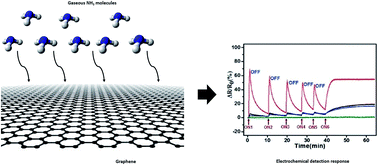Graphene materials as a superior platform for advanced sensing strategies against gaseous ammonia
Abstract
Ammonia (NH3) is an uncolored, toxic, corrosive, and reactive gas with a characteristic pungent stench. To date, quantitative analysis of NH3 concentrations have been made using conventional techniques (e.g., ion chromatography). In light of the complications involved in such applications, efforts have been made to develop detection methods of NH3 that are more sensitive and selective. In this respect, graphene-based gas sensors have attracted widespread attention because of graphene's distinctive electrical characteristics (e.g., low electrical signal noise and great mobility) and large surface area. This review article was designed to evaluate the potential usage of graphene-based gas sensors for effective detection of NH3. We aim to understand the recent advances in this challenging area of research by critically analyzing various experiments and comprehending their practical implications. This review critically compares the performance of graphene-based NH3 sensors with those of other nanomaterials for a broader understanding of the field. Also, we summarize the future prospects for advancement of graphene technology for NH3 sensing.



 Please wait while we load your content...
Please wait while we load your content...